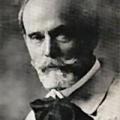 Louis-Philippe Hébert, of Acadian background, was born in Sainte-Sophie-de-Halifax in 1850. At age 19, Hébert left his parents' farm to join the Papal Zouaves, an army created by the Catholic Church to defend Rome against the forces of Italian unification. In Europe, Hébert was exposed to a world of art and culture such as he had never seen before. So inspired by what he saw, upon his return to Canada, he went to work and study under artist Napoléon Bourassa in Montreal, and for 6 years learned the art of sculpture. In the early 1880s, Hébert began to receive commissions of his own, mostly for work in churches, and mostly in wood. He was becoming better known, however, and in a few years began to receive commissions for public sculpture in bronze.
Louis-Philippe Hébert, of Acadian background, was born in Sainte-Sophie-de-Halifax in 1850. At age 19, Hébert left his parents' farm to join the Papal Zouaves, an army created by the Catholic Church to defend Rome against the forces of Italian unification. In Europe, Hébert was exposed to a world of art and culture such as he had never seen before. So inspired by what he saw, upon his return to Canada, he went to work and study under artist Napoléon Bourassa in Montreal, and for 6 years learned the art of sculpture. In the early 1880s, Hébert began to receive commissions of his own, mostly for work in churches, and mostly in wood. He was becoming better known, however, and in a few years began to receive commissions for public sculpture in bronze.
By the 1890s, he was acknowledged as the finest sculptor of his day. Some of his more important commissions included statues of John A. Macdonald and Queen Victoria (Ottawa); Maisonneuve; Jeanne Mance; and Edward VII (Montreal); Mgr. Laval (Quebec City); and the South Africa War Memorial (Calgary). There were many others. He is perhaps best known for the set of bronzes that adorn the facade of Quebec's National Assembly. Hébert also sculpted busts, funerary monuments, commemorative medals, and statuettes for private clients. He worked in wood and terra cotta, but his greatest achievements were his works in bronze.
 Hébert was recognized by his peers and the public. Sir Arthur Conan Doyle, on a trip to Montreal in 1915, wrote that he was "moved deeply" by the artist's work. Indeed, he doubted "if we have any finer sculptor living." Hébert's accolades were many. He was a Member of the Royal Canadian Academy of Arts (1880), received a Medal of Confederation (1894), and was made both a Chevalier of the Legion d'honneur (France, 1901) and a Companion of St. Michael and St. George (Britain, 1903). Louis-Philippe Hébert, who died in 1917, is recognized as one of the greatest artists this country has produced.
Hébert was recognized by his peers and the public. Sir Arthur Conan Doyle, on a trip to Montreal in 1915, wrote that he was "moved deeply" by the artist's work. Indeed, he doubted "if we have any finer sculptor living." Hébert's accolades were many. He was a Member of the Royal Canadian Academy of Arts (1880), received a Medal of Confederation (1894), and was made both a Chevalier of the Legion d'honneur (France, 1901) and a Companion of St. Michael and St. George (Britain, 1903). Louis-Philippe Hébert, who died in 1917, is recognized as one of the greatest artists this country has produced.